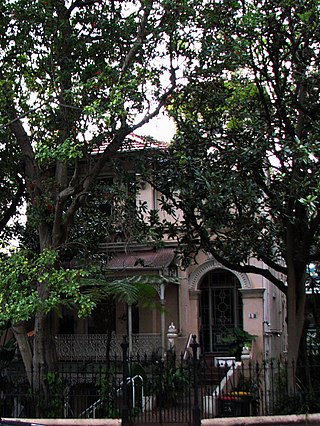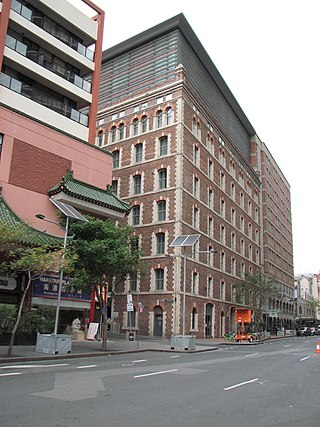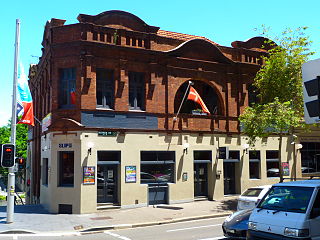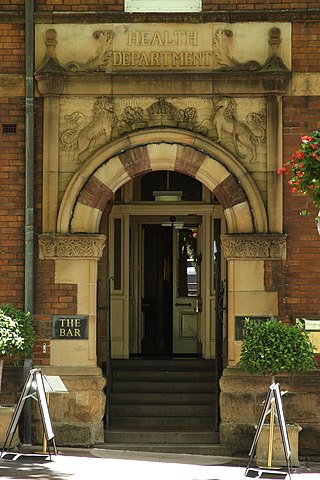
The Sydney central business district (CBD) is the historical and main commercial centre of Sydney. The CBD is Sydney's city centre, or Sydney City, and the two terms are used interchangeably. Colloquially, the CBD or city centre is often referred to simply as "Town" or "the City". The Sydney city centre extends southwards for about 3 km (2 mi) from Sydney Cove, the point of first European settlement in which the Sydney region was initially established. Due to its pivotal role in Australia's early history, it is one of the oldest established areas in the country.
The Cadigal, also spelled as Gadigal and Caddiegal, are a group of Indigenous people whose traditional lands are located in Gadi, on Eora country, the location of Sydney, New South Wales, Australia.

Sussex Street is a street in the central business district of Sydney in New South Wales, Australia. It runs north-south along the western side of the city, between Hickson Road and Hay Street. It is in the local government area of the City of Sydney. The street is 1.7 kilometres (1.1 mi) long. It was named in honour of Prince Augustus Frederick, Duke of Sussex, the sixth son of King George III.

Oakleigh is a heritage-listed residence and former boarding house at 18 Ward Avenue in the inner city Sydney suburb of Potts Point in the City of Sydney local government area of New South Wales, Australia. It was built c. 1880 on the former estate of the now-demolished Goderich Lodge. It was added to the New South Wales State Heritage Register on 2 April 1999.

55 Victoria Street is a heritage-listed residence and former boarding house and Catholic Women's Association hostel located at 55 Victoria Street in the inner city Sydney suburb of Potts Point in the City of Sydney local government area of New South Wales, Australia. It was built in 1875. It was added to the New South Wales State Heritage Register on 2 April 1999.

Jenner House is a heritage-listed residence located at 2 Macleay Street in the inner city Sydney suburb of Potts Point in the City of Sydney local government area of New South Wales, Australia. It was designed by Edmund Blacket and built in 1871, with an 1877 third-floor addition designed by Thomas Rowe. It has also been known as Fleet Club, Stramshall, Jenner Private Hospital, Kurragheen and Lugano. It was added to the New South Wales State Heritage Register on 2 April 1999.

The Captain Cook Hotel is a heritage-listed pub located at 33-35 Kent Street, in the inner city Sydney suburb of Millers Point in the City of Sydney local government area of New South Wales, Australia. It was added to the New South Wales State Heritage Register on 2 April 1999.

75-77 Lower Fort Street is a heritage-listed shop and residence located at 75 and 77 Lower Fort Street, in the inner city Sydney suburb of Millers Point, in the City of Sydney local government area of New South Wales, Australia. It was added to the New South Wales State Heritage Register on 2 April 1999.

79 Lower Fort Street is a heritage-listed former hotel and now shop and residence at 79 Lower Fort Street, Millers Point, City of Sydney, New South Wales, Australia. It was built in 1842 as a hotel, and variously traded as a hotel or shop until 1870, after which time it operated solely as a shop. It was variously known as the Young Princess Hotel, Whalers Arms Hotel and Brown's Family Hotel in its licensed years. It was added to the New South Wales State Heritage Register on 2 April 1999.

Crown Hotel is a heritage-listed hotel at 160–162 Elizabeth Street, Sydney, City of Sydney, New South Wales, Australia. It was added to the New South Wales State Heritage Register on 2 April 1999.

Metropolitan Hotel is a heritage-listed hotel at 244 George Street, Sydney, Australia. It was added to the New South Wales State Heritage Register on 2 April 1999.

The John Bridge Woolstore is a heritage-listed former warehouse located at 64 Harbour Street, in the Sydney central business district, in the City of Sydney local government area. It was probably designed by either William Pritchard or his son Arthur Pritchard, and was built by Stuart Bros. in 1889. It was added to the New South Wales State Heritage Register on 2 April 1999.

The Skinners Family Hotel is a heritage-listed former pub and now retail optometrist shop, located at 296 George Street, in the Sydney central business district, in the City of Sydney local government area of New South Wales, Australia. It was added to the New South Wales State Heritage Register on 2 April 1999.

Royal George Hotel is a heritage-listed pub located at 115–117 Sussex Street, in the Sydney central business district, in the City of Sydney local government area of New South Wales, Australia. It was built in 1903. The adjoining former Cuthbert's Patent Slip building, assumed to date from 1869 and also heritage-listed, has also been incorporated into the hotel complex in recent decades. The hotel now operates as the Slip Inn. It was added to the New South Wales State Heritage Register on 2 April 1999.

The Sussex Hotel is a heritage-listed hotel at 20 Sussex Street, Sydney, New South Wales, Australia. It was built from 1913 to 1915. Historically known as the New Hunter River Hotel, it was known as the Big House Hotel from 1973 until 1991, then as Napoleon's Hotel, Moreton's on Sussex and Moreton's Hotel before adopting its current name. It was added to the New South Wales State Heritage Register on 2 April 1999.

The Dundee Arms Hotel, commonly called The Dundee Arms, is a heritage-listed pub located at 171 Sussex Street, in the Sydney central business district, in the City of Sydney local government area of New South Wales, Australia. It was built in 1860. It was added to the New South Wales State Heritage Register on 2 April 1999.

93-97 Macquarie Street, Sydney or formerly the Health Department building is a heritage-listed former government office, health clinic and hospital admissions depot and now hotel at 93-97 Macquarie Street, in the Sydney central business district, in the City of Sydney local government area of New South Wales, Australia. It was designed by Walter Liberty Vernon and NSW Government Architect and built from 1896 to 1898. It is currently part of the Sir Stamford Hotel, which formerly was a Ritz Carlton Hotel. In its history it has also been used as the Venereal Disease Clinic, STD Clinic, Hospital Admissions Depot and Former Health Board Offices. It was added to the New South Wales State Heritage Register on 9 October 2013.

181-187 Hay Street, also known as the Corporation Building or Municipal Building, is a heritage-listed former council chambers located at 181-187 Hay Street, in the Haymarket district of Sydney, Australia. It was built from 1893. The property is owned by City of Sydney and was added to the New South Wales State Heritage Register on 2 April 1999.

121-127 Sussex Street is a heritage-listed former warehouse and now commercial office building located at 121-127 Sussex Street, in the Sydney central business district, in the City of Sydney local government area of New South Wales, Australia. It was built during 1850. The property is owned by Property NSW, an agency of the Government of New South Wales. It was added to the New South Wales State Heritage Register on 2 April 1999.

The Bulletin Place Warehouses are a series of three heritage-listed former warehouses and now souvenir sales office, commercial offices, health club, storage area, and restaurant located between 6–18 Bulletin Place, in the Sydney central business district in the City of Sydney local government area of New South Wales, Australia. The warehouses were built from 1880 and have variously been known as the San Francisco Restaurant. The property is privately owned. It was added to the New South Wales State Heritage Register on 2 April 1999.




















